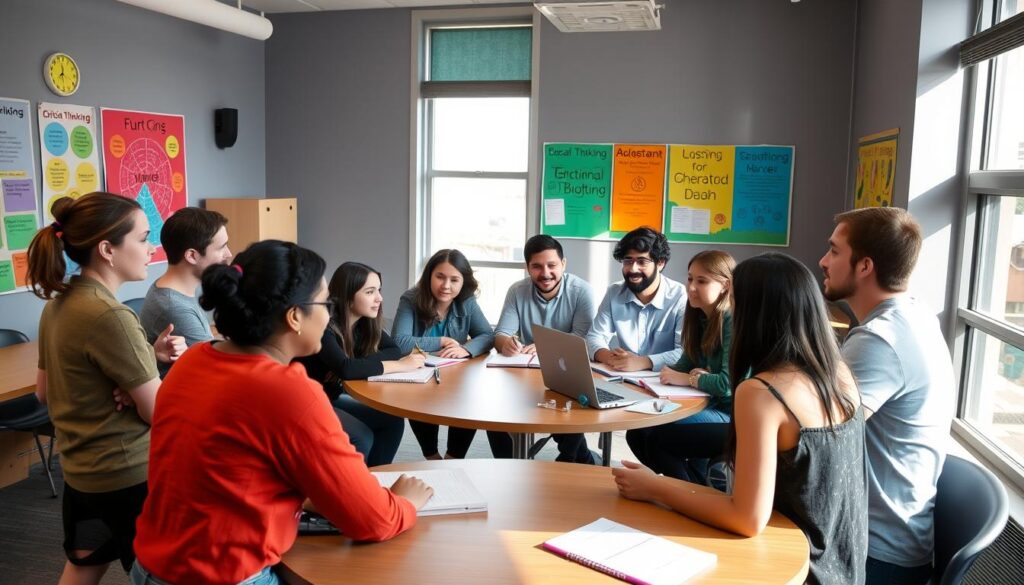In today’s world, being able to think critically and analyze information is key. Group discussions are a great way to improve these skills. They help students solve complex problems, come up with new ideas, and understand different views.
Thinking analytically means breaking down info, finding patterns, and making logical conclusions. In group talks, students get better at this by sharing ideas, working together, and looking at things from different angles. This way of learning is like the Socratic method, where students question, analyze, and put together new knowledge.
Key Takeaways
- Group discussions help improve critical thinking and analytical skills by encouraging active participation, diverse views, and teamwork.
- Using open-ended questions, wait time, and probing questions can lead to more thoughtful discussions.
- Role-playing and debates can sharpen analytical skills and help students develop problem-solving strategies.
- Encouraging diverse viewpoints in class challenges students to think differently, improving their analytical skills.
- Learning together in group discussions helps students share their thoughts, defend their views, and consider others’ perspectives. This is crucial for critical thinking.
Understanding the Power of Group Discussions
Group discussions are a powerful tool for learning and thinking. Students don’t just listen; they work together to learn. This way, they challenge ideas, ask questions, and improve their thinking.
This process is like the Socratic method. It helps students grow their critical thinking skills through questioning and dialogue.
The Importance of Dialogue in Learning
Dialogue is crucial in group discussions. It brings together different voices and ideas. Students learn by sharing their views and listening to others.
This exchange helps them see things from different angles. It makes them think more deeply about what they’re learning.
Promoting Active Engagement and Collaborative Learning
Group discussions encourage students to be active and work together. This is key for developing critical thinking. When students take part, they learn more deeply.
This teamwork helps them question and analyze information. It makes them better at solving problems and thinking critically.
“The power of dialogue lies in its ability to unlock the symphony of voices, creating a tapestry of thought that enriches the educational experience.”
Using group discussions, teachers can help students think better and learn more. This way of learning keeps students engaged. It also prepares them for the world’s challenges, where thinking critically and working together are essential.
Setting the Stage for Effective Discussions

For group discussions to be successful, the right setting is key. Start by setting clear ground rules for respectful communication. Create a supportive learning environment where students feel comfortable sharing their ideas without fear of judgment.
Establishing Ground Rules for Respectful Communication
Setting clear expectations is vital. Encourage active listening and mutual respect. Make sure discussions stay on topic. This keeps the conversation coherent and productive, allowing everyone to be heard.
- Encourage active listening and respect for diverse perspectives
- Promote mutual understanding and avoid interruptions
- Ensure discussions stay focused and on-topic
Creating a Supportive Learning Environment
A safe space is crucial for students to share their thoughts freely. Create a place of trust, empathy, and openness. Here, people can share their views without fear of judgment.
- Establish clear expectations for participation and engagement
- Encourage a culture of mutual respect and active collaboration
- Facilitate discussions in a manner that promotes a coherent flow of ideas
With well-defined ground rules and a supportive environment, you can foster effective group discussions. These discussions unlock the power of critical thinking and teamwork.
Strategies for Facilitating Engaging Group Discussions

Creating engaging group discussions is key in the classroom. It helps students think critically and analyze well. By using different strategies, teachers can make discussions lively and thought-provoking.
Using Questioning Techniques to Stimulate Critical Thinking
Good questions are essential for sparking critical thinking. Teachers should ask open-ended questions and give wait time. This lets students share their ideas fully. Probing questions help dig deeper into their thoughts.
Think-pair-share is another great method. It involves thinking alone, then discussing with a partner, and finally sharing with the whole group. This method boosts teamwork and brings out different views.
Incorporating Role-Playing and Debates
Role-playing and debates add excitement to discussions. Students take on roles and defend positions. This helps them think critically and share their thoughts clearly. It also helps them understand different viewpoints better.
| Technique | Description | Benefits |
|---|---|---|
| Open-ended questions | Questions that cannot be answered with a simple yes or no, encouraging students to elaborate and share their thoughts. | Stimulates critical thinking and in-depth discussion. |
| Wait time | Allowing a brief pause after asking a question, giving students time to formulate their responses. | Encourages more thoughtful and substantive responses. |
| Probing questions | Follow-up questions that delve deeper into a student’s initial response, seeking clarification or additional insights. | Promotes deeper understanding and analysis of the topic. |
| Think-pair-share | A cooperative learning strategy where students first think individually, then discuss with a partner, and finally share their ideas with the larger group. | Fosters collaboration, diverse perspectives, and active engagement. |
Using these strategies, teachers can lead engaging and effective group discussions. These discussions help students think critically and analyze well.
Nurturing Critical Thinking Through Group Discussions
Critical thinking is key to success in school and personal growth. Group discussions help students learn to analyze, evaluate, and synthesize. These skills are vital for critical thinking.
These talks let students break down complex ideas. They learn to check if information is true and find the best sources. This way, they grow to handle the world’s challenges with confidence.
Promoting Analysis, Evaluation, and Synthesis
Group talks help students understand complex ideas by breaking them down. They learn to see patterns and connections. This helps them evaluate information and come up with new ideas.
- Develop analytical skills to break down arguments and assess information
- Evaluate the credibility and relevance of various sources
- Synthesize diverse ideas to generate innovative solutions and new theories
- Apply critical thinking to real-world problems and decision-making
By focusing on critical thinking in group talks, teachers help students face the world’s challenges. They grow to be creative and independent thinkers.
Group Discussions

Classroom discussions are key to fostering inclusivity and celebrating diversity. By valuing each student’s unique perspective, educators create a fair learning space. This space prepares students to succeed in our diverse world.
Group discussions help share diverse viewpoints and challenge assumptions. They deepen our understanding of different experiences and backgrounds.
When every student’s voice is heard and respected, learning becomes richer. Students are empowered to engage in meaningful dialogue and share knowledge. Graded group discussions, for example, improve critical thinking skills.
Students learn to express their views clearly within groups. The grading process keeps students accountable and helps develop discussion ideas.
Promoting Inclusive Participation
Instructors can grade discussions, setting participation deadlines to encourage student engagement. They can also grade individual group members, providing personalized feedback.
Discussion analytics help instructors understand class performance and group contributions. This data informs the design of effective discussion questions. It uses frameworks like Bloom’s Taxonomy to assess and develop higher-order cognitive skills.
When every student’s voice is heard and valued, the learning environment becomes richer, and students are empowered to engage in meaningful dialogue and knowledge sharing.
Group discussions that value diversity empower students to challenge assumptions and share knowledge. They thrive in a world that celebrates different perspectives.
Integrating Group Discussions into the Curriculum

Skills like analytical thinking are useful in many subjects. Group discussions can make learning better in math, science, language arts, and social studies. They help students think critically and improve their grades.
Identifying Opportunities Across Subjects
Group discussions can make learning fun and deep. In math, they help solve problems together. In science, they analyze data and come up with new ideas.
In language arts and social studies, they help understand complex topics. They also improve reading and communication skills.
Designing Discussion-Based Assignments and Projects
- Use group discussions for assignments that tackle real-world problems.
- They help students develop skills like problem-solving and communication.
- Activities should make students think from different angles and come to conclusions.
This way of learning gets students ready for the future. It helps them succeed in school and beyond.
| Subject | Discussion-Based Opportunities |
|---|---|
| Math | Collaborative problem-solving, analysis of data and patterns |
| Science | Hypothesis testing, evaluation of scientific evidence, proposed solutions |
| Language Arts | Literary analysis, exploration of themes and symbolism, debating interpretations |
| Social Studies | Examination of historical events, discussion of current issues, consideration of different perspectives |
“Engaging students in group discussions across the curriculum not only enhances their critical thinking skills but also prepares them for the collaborative and problem-solving demands of the 21st century.”
Assessing the Impact of Group Discussions
It’s important to check how well group discussions work in learning. We can use different ways to see if students are getting better at thinking critically. This includes looking at how well they handle complex ideas.
Formal Assessment Methods
One way to assess is through participation grades. Teachers look at how well the group works together. This can be in things like presentations or reports.
Some teachers split the grade between the group and individual work. Others might give more weight to group work, like 75% of the grade.
Informal Assessment Methods
Another way is through reflective journals. Students write about what they learned from the discussions. Teachers can also check in during discussions to see if students understand.
After the discussions, teachers might ask for feedback through surveys or interviews. This helps see how much students learned and if they met their goals.
Teachers can use both numbers and words to understand what’s working. This helps make future discussions better. It’s all about improving and learning together.
| Assessment Method | Description |
|---|---|
| Participation Grades | Evaluating group performance (e.g., design, report, presentation) and group processes (e.g., ability to meet deadlines, contribute fairly, communicate effectively) |
| Reflective Journals | Collecting student feedback and insights gained from the group discussions |
| Formative Assessments | Gauging real-time understanding and engagement through polls, check-in questions, and observations |
| Summative Assessments | Evaluating the impact on adult learners and assessing the achievement of learning objectives through surveys and interviews |
| Quantitative Data | Tracking participation metrics, such as attendance, contribution frequency, and engagement levels |
| Qualitative Insights | Collecting feedback through interviews and focus groups to understand participants’ experiences and opinions |
By using many ways to assess, teachers can really understand the value of group discussions. This helps make learning better for everyone.
Also Read : How Teacher Training Workshops Can Transform Student Outcomes
Conclusion
Group discussions are a great way to improve critical thinking and analytical skills. They make learning more active and engaging. By welcoming different views and creating a supportive space, teachers help students grow.
Using methods like asking good questions and role-playing, group talks help students think deeply. They learn to analyze, evaluate, and synthesize information. These skills are vital for success today.
These discussions can be used in many subjects to boost learning. It’s important to check how well they work to improve critical thinking. By using group talks, both teachers and students can achieve more in their studies.
Creating a space where everyone can share and listen is key. Teachers can use the Socratic method and other techniques to spark critical thinking. This leads to better analysis and problem-solving skills.
Adding group talks to different subjects helps everyone participate and do better in school. Students learn to work together and solve tough problems. This approach makes learning more inclusive and effective.
FAQs
Q: What is the importance of group discussions for critical thinking?
A: Group discussions are vital for fostering critical thinking as they allow members to engage with diverse perspectives, analyze others’ ideas, and collaboratively evaluate different viewpoints, enhancing their analytical skills.
Q: How can I create a group discussion that encourages participation?
A: To create a group discussion that encourages participation, select a relevant discussion topic that interests all members of the group, assign roles such as a group leader to guide the discussion, and establish a supportive environment for sharing ideas.
Q: What types of group discussions can be conducted to enhance critical thinking?
A: There are various types of group discussions, including small group discussions, brainstorming sessions, and structured debates, each designed to stimulate critical analysis and collaborative thinking among members of a group.
Q: What skills are evaluated in group discussions?
A: Skills evaluated in group discussions include communication, active listening, the ability to summarize others’ ideas, critical thinking, and the effectiveness of body language in conveying thoughts and engaging with the group as a whole.
Q: What are common mistakes to avoid when facilitating a group discussion?
A: Common mistakes to avoid include dominating the conversation, failing to include quieter members of the group, not sticking to the discussion topic, and allowing distractions that can derail the focus of the discussion.
Q: If I need more help with creating a group discussion, where can I turn?
A: If you need more help, consider reaching out to educational resources, joining discussion boards, or seeking advice from experienced facilitators who can provide guidance on how to effectively create a group discussion.
Q: How do I select a group for a discussion?
A: To select a group for a discussion, consider the members’ interests, backgrounds, and expertise related to the discussion topic, ensuring a diverse range of perspectives that can enrich the conversation.
Q: What are some tips for summarizing a group discussion effectively?
A: To summarize a group discussion effectively, listen actively throughout, take notes on key points, highlight the main arguments presented, and ensure that the summary reflects the group’s consensus and diverse opinions.
Q: How can body language impact a group discussion?
A: Body language plays a critical role in group discussions as it can convey engagement, openness, and confidence. Positive body language, such as eye contact and nodding, encourages participation and signals respect for others’ ideas.
Q: How can I view and evaluate the effectiveness of a group discussion?
A: To view and evaluate the effectiveness of a group discussion, observe the interactions among members, assess how well the discussion stayed on topic, and reflect on whether all members had the opportunity to contribute their thoughts and ideas.
Source Links
- https://waywithwords.net/resource/critical-thinking-analytical-skills/
- https://teachers.institute/operational-dimensions-education/critical-thinking-classroom-discussion-strategies/
- https://www.teachhub.com/teaching-strategies/2014/09/teaching-strategies-to-promote-critical-thinking/
- https://www.engageli.com/blog/talk-less-teach-more-the-power-of-small-group-discussions
- https://www.chieflearningofficer.com/2023/09/18/the-power-of-group-learning/
